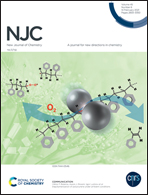Mononuclear copper(ii) Schiff base complex: synthesis, structure, electrical analysis and protein binding study†
Abstract
In this work, we report a distorted square pyramidal mononuclear copper(II) complex [Cu(L)(N3)] (1), which was synthesized from a tetradentate Schiff base (HL), prepared by the condensation of salicylaldehyde and N-2-(aminoethyl)-1,3-propanediamine. Complex 1 has been successfully characterized based on elemental analysis, IR spectroscopy, UV-Vis spectroscopy, ESI-MS, PXRD and FESEM. The structure of the complex is confirmed using a single-crystal X-ray diffraction study. The DFT, molecular dynamics and solid-state quantum mechanical calculations of the DOS of the compound are also studied. Annealing of complex 1 at 320, 340 and 360 K considering the Al-1-Al planar structure confirms the gradual decrease in electrical conductivity. The current–voltage characteristics of the Al-1-ITO planar structure are studied using the thermionic emission model of the Schottky barrier diode and the device parameters are estimated using the conventional method. The DFT, molecular dynamics and solid-state quantum mechanical calculations of the DOS of complex 1 are also studied. In addition, we explore the protein interaction ability of the complex with bovine serum albumin (BSA) with the help of spectroscopy and docking studies.



 Please wait while we load your content...
Please wait while we load your content...